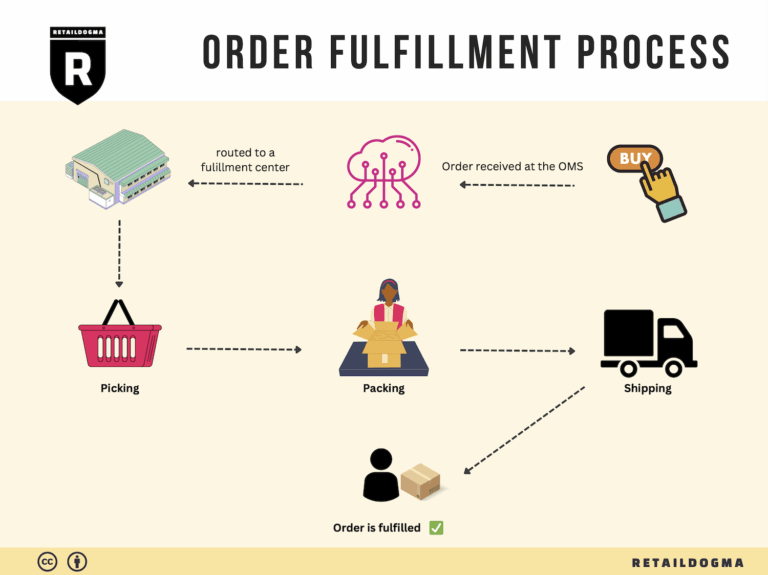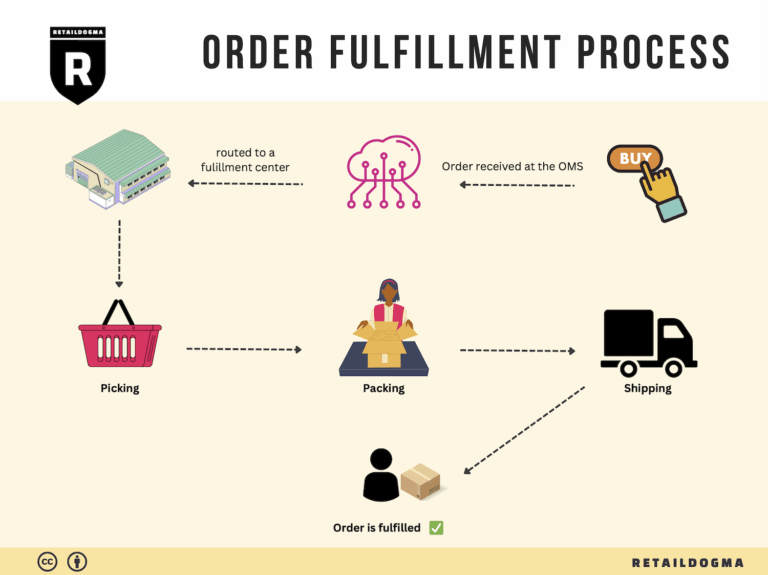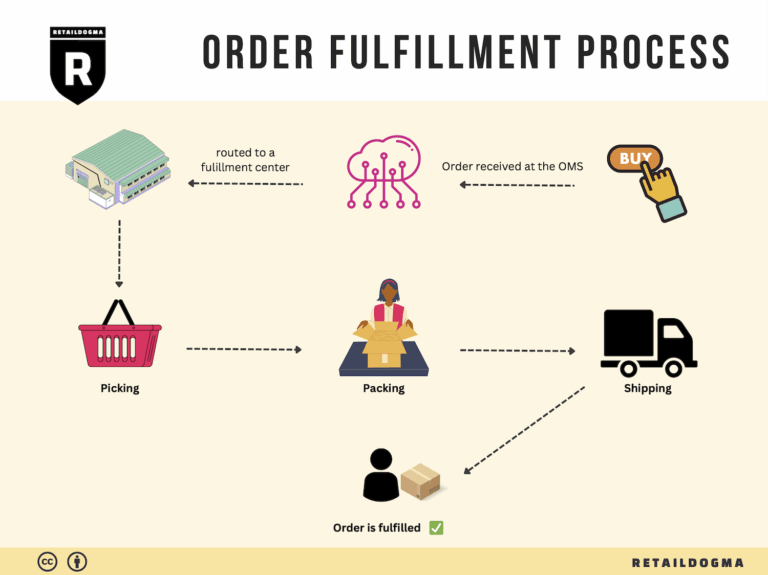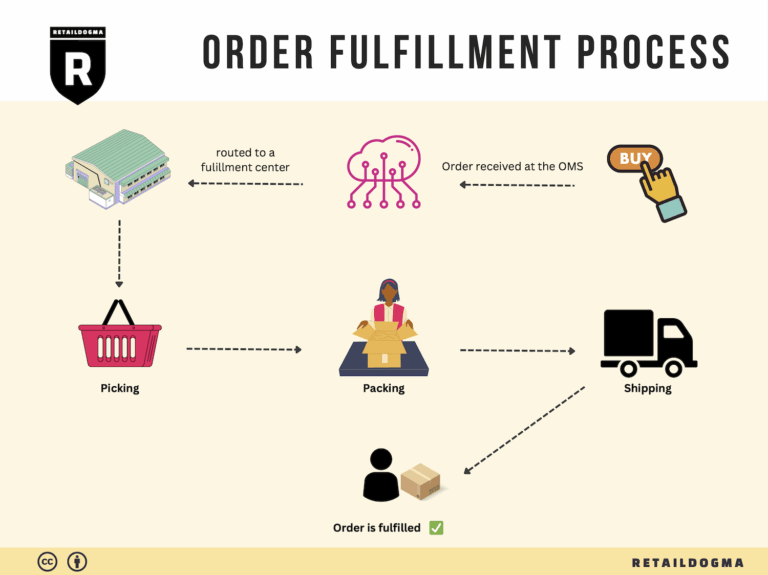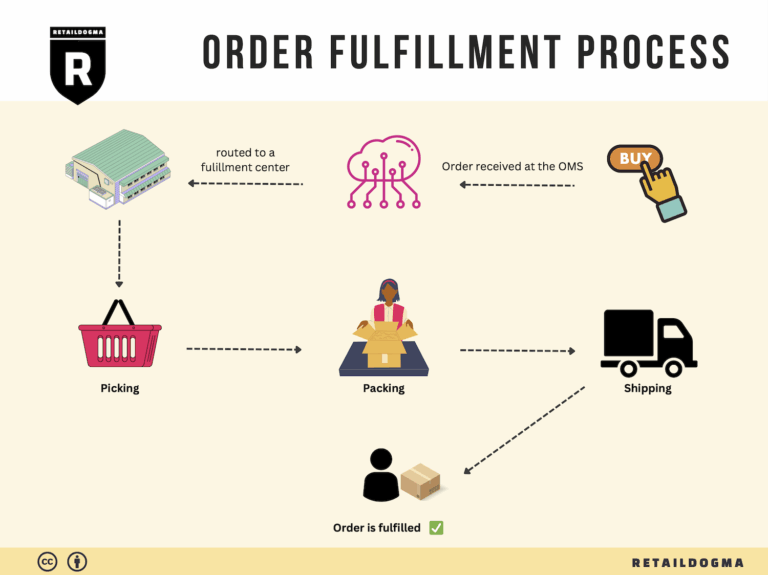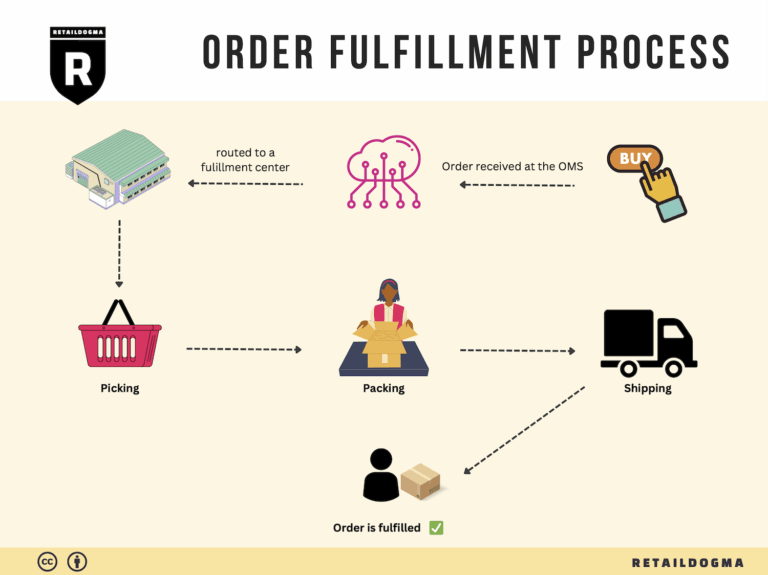What Is A Fulfillment Center? A Complete Guide (2025)
What is E-commerce Fulfillment? An Introduction for Growing Businesses
Understanding E-commerce Fulfillment
As an e-commerce business owner, you may find yourself grappling with a common challenge: the overwhelming demands of packing and shipping orders. It’s a crucial aspect of your operations that can quickly become burdensome, particularly as your sales start to grow. The fulfillment process—the journey of getting a product from your inventory to your customer’s doorstep—can become complex and time-consuming, often diverting your attention from strategic growth initiatives.
Fulfillment encompasses all the steps involved in processing an order, from receiving inventory to shipping it out. It includes managing stock, picking items from shelves, packing them efficiently, and ensuring timely delivery to customers. As you scale your business, understanding the intricacies of fulfillment becomes essential to maintaining customer satisfaction and operational efficiency.
This guide is designed to demystify e-commerce fulfillment for growing businesses like yours. We will explore various fulfillment models available to you, including Third-Party Logistics (3PL) and Fulfillment by Amazon (FBA). Each model has its unique advantages, and understanding these can help you select the one that aligns best with your business goals.
We will delve into the core services provided by fulfillment partners, including inventory management, order processing, shipping, and customer service. You’ll learn what to look for in a fulfillment partner, such as their technology capabilities, service levels, and geographic reach, ensuring that you choose a partner that complements your operational needs.
Additionally, pricing structures can vary widely among fulfillment services. This guide will provide insights into common pricing models, helping you to anticipate costs and budget effectively as you scale.
The ultimate goal of this guide is to empower you with the knowledge needed to make informed decisions about your logistics strategy. By understanding e-commerce fulfillment, you can streamline your operations, reduce overhead, and focus on what you do best: growing your business and delighting your customers. With the right fulfillment strategy in place, you can transform a potential pain point into a powerful enabler of your e-commerce success.
What You’ll Learn In This Guide
- What is E-commerce Fulfillment? An Introduction for Growing Businesses
- The Order Fulfillment Process: From ‘Buy’ Button to Customer’s Door
- Comparing Fulfillment Models: In-House vs. 3PL vs. Dropshipping
- A Deep Dive into Amazon FBA: Pros, Cons, and Who It’s For
- Core Services Offered by Fulfillment Centers
- How to Choose a Fulfillment Partner: A 6-Point Checklist
- Understanding Fulfillment Pricing: A Breakdown of Common Fees
- Frequently Asked Questions (FAQs) about Fulfillment
- Conclusion: Is Outsourcing Fulfillment the Right Move for Your Business?
- Important Disclaimer
The Order Fulfillment Process: From ‘Buy’ Button to Customer’s Door
1. Receiving Inventory
The order fulfillment process begins with receiving inventory at the fulfillment center. When products arrive, they are checked against purchase orders to ensure accuracy. This step is critical because it sets the foundation for the entire fulfillment operation. Accurate receiving minimizes the risk of inventory discrepancies, which can lead to stockouts or overstock situations.
During this stage, each item is assigned a Stock Keeping Unit (SKU), a unique identifier that allows for easy tracking and management of inventory. The received products are unloaded from trucks, typically using forklifts, and sorted based on their source—whether they are from vendors or other Amazon facilities. Effective receiving processes ensure that the inventory is ready for the next stages, which directly impacts order accuracy and customer satisfaction.
2. Warehouse Storage
Once the inventory has been received, it is then stored within the fulfillment center. This stage involves organizing the products in a systematic manner, which is essential for efficient retrieval later on. Proper warehouse storage optimizes space and improves the speed of order fulfillment.
At Amazon fulfillment centers, items are stowed using a dynamic storage system that records their location via barcode scanning. This system allows for real-time tracking of inventory levels and locations, facilitating quick access when orders are placed. The importance of effective storage cannot be overstated; it directly correlates with operational efficiency, enabling faster picking and packing processes.
3. Order Picking
When a customer places an order, the next step is order picking. This process involves selecting the correct items from their storage locations based on the order details. It is a crucial part of the fulfillment process, as errors at this stage can lead to incorrect shipments and dissatisfied customers.
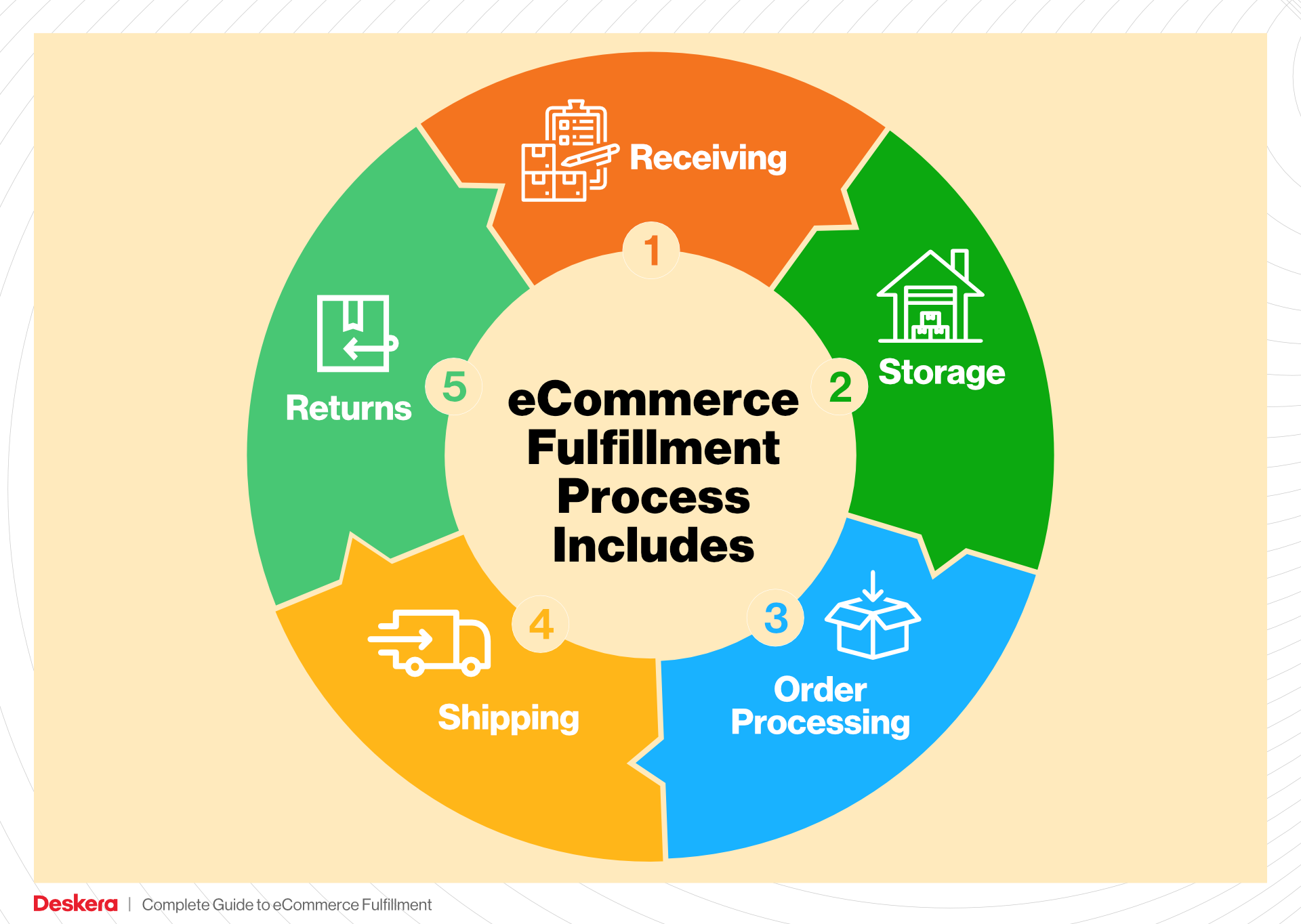
In fulfillment centers like Amazon’s, pick lists are generated automatically, guiding warehouse associates to the correct locations. The picking process can be enhanced through automation, such as using robots that bring storage pods to pick stations, thus reducing the time spent walking through the warehouse. Efficient order picking is vital for maintaining a fast turnaround time on orders, which is a significant competitive advantage in e-commerce.
4. Order Packing
After items have been picked, they move to the order packing stage. Here, the picked items are carefully packed into boxes, ensuring they are secure for transit. This step is important not only for protecting the products during delivery but also for optimizing shipping costs.
Packing stations are equipped with technology that helps determine the most suitable box size for each order, minimizing waste. The packing process involves scanning items to verify accuracy, which ensures that customers receive exactly what they ordered. The use of pack lists and automated systems to measure the right amount of packing materials helps streamline this process. Efficient packing contributes to lower shipping costs and enhances the overall customer experience by ensuring that products arrive safely and on time.
5. Shipping & Delivery
The final step in the order fulfillment process is shipping and delivery. Once the orders are packed, they are labeled and sorted based on their destination and shipping method. This stage is crucial for ensuring that packages reach customers in a timely manner, which is a key factor in customer satisfaction.
At fulfillment centers, advanced systems like SLAM (Scan, Label, Apply, Manifest) machines are used to automate the labeling process, significantly speeding up operations. Packages are then sorted according to delivery speed, with options ranging from standard shipping to expedited services like Amazon Prime. The choice of transportation—whether by truck, plane, or even drones—depends on the delivery requirements. A well-optimized shipping and delivery process not only enhances customer satisfaction but also helps businesses scale by improving efficiency and reducing costs.
In summary, the order fulfillment process is a complex but well-orchestrated series of steps that directly affects customer satisfaction and operational efficiency. By understanding and optimizing each step—from receiving inventory to shipping and delivery—e-commerce businesses can significantly enhance their fulfillment operations and scale effectively.
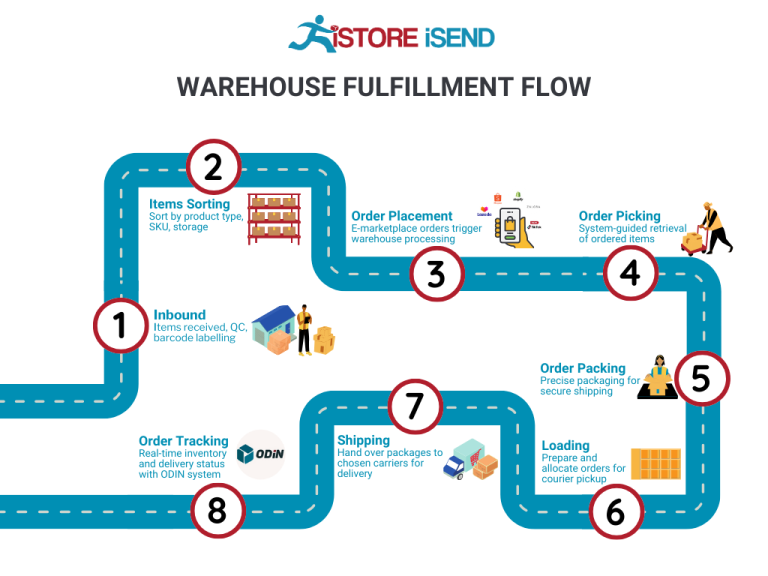
Comparing Fulfillment Models: In-House vs. 3PL vs. Dropshipping
Fulfillment Model Comparison
| Model | Who Handles Inventory | Best For (Business Stage) | Key Advantage | Key Disadvantage |
|---|---|---|---|---|
| In-House Fulfillment | The business itself | Startups to mid-sized businesses | Full control over inventory and processes | High overhead costs and resource requirements |
| Third-Party Logistics (3PL) | A third-party logistics provider | Growing businesses and scaling firms | Scalability and access to expertise | Less control over inventory and shipping |
| Dropshipping | Supplier/manufacturer | New businesses or niche sellers | Low startup costs and minimal risk | Lower profit margins and reliance on suppliers |
In-House Fulfillment
In-house fulfillment involves a business managing its own warehousing, inventory management, picking, packing, and shipping processes. This model is often favored by startups and mid-sized businesses that prioritize having full control over their supply chain and customer experience. By handling fulfillment in-house, businesses can tailor their processes to meet specific customer needs and maintain direct oversight of inventory levels. This can lead to improved efficiency and customer satisfaction, as products can be shipped directly from the warehouse. However, this model comes with significant overhead costs, including rent, utilities, labor, and technology. As a business grows, scaling operations in-house can become increasingly complex and resource-intensive, making it essential to evaluate whether this model remains viable as sales volumes increase.
Third-Party Logistics (3PL)
Third-party logistics (3PL) providers offer businesses a way to outsource their fulfillment processes. This model is especially beneficial for growing businesses that may not have the resources or expertise to manage logistics effectively. With a 3PL, companies can leverage the provider’s established infrastructure, technology, and expertise to streamline their supply chain operations. This allows businesses to focus on core competencies such as marketing and product development while benefiting from faster shipping and improved customer service. Additionally, 3PLs often provide scalability, enabling businesses to adjust their logistics needs according to fluctuating demand without the burden of managing physical inventory. On the downside, outsourcing fulfillment to a 3PL means relinquishing some control over the inventory and shipping processes, which can lead to issues with communication and fulfillment errors if the partnership is not managed effectively.
Dropshipping
Dropshipping is a fulfillment model where a business sells products without holding any inventory. Instead, when a customer places an order, the business purchases the item from a supplier who then ships it directly to the customer. This model is ideal for new entrepreneurs or niche sellers who want to minimize startup costs and financial risk. Since there are no inventory holding costs, businesses can offer a wide variety of products without the need for upfront investment in stock. However, dropshipping can also present challenges, such as lower profit margins due to reliance on suppliers for fulfillment and potential delays in shipping. Additionally, the business has limited control over product quality and delivery times, which can impact customer satisfaction. As a result, while dropshipping can be an attractive entry point into e-commerce, it requires careful supplier management and a strong marketing strategy to succeed.
Conclusion
Choosing the right fulfillment model is critical for the success of an e-commerce business. Each model offers distinct advantages and disadvantages that must align with the business’s goals, resources, and growth stage. In-house fulfillment provides control but comes with higher costs, while 3PL offers scalability and expertise but requires a relinquishment of some control. Dropshipping presents a low-risk entry point into e-commerce but can lead to challenges with profit margins and supplier reliability. Ultimately, businesses must assess their unique needs and capabilities when selecting a fulfillment strategy to ensure they can meet customer demands while effectively scaling operations.
A Deep Dive into Amazon FBA: Pros, Cons, and Who It’s For
Understanding Fulfillment by Amazon (FBA)
Fulfillment by Amazon (FBA) is a service provided by Amazon that allows e-commerce sellers to store their products in Amazon’s fulfillment centers. When a customer makes a purchase, Amazon takes care of the entire fulfillment process, including storage, packaging, and shipping of the products. This service has become a cornerstone for many sellers on the Amazon platform, enabling them to leverage Amazon’s vast logistics network and customer base.
How FBA Works
-
Inventory Preparation: Sellers prepare their products according to Amazon’s guidelines, which include proper labeling and packaging. They then ship their inventory directly to one or more of Amazon’s fulfillment centers.
-
Storage: Once the products arrive at the fulfillment center, they are stored until an order is placed. Amazon uses sophisticated inventory management systems to track items and optimize storage space.
-
Order Processing: When a customer orders a product, Amazon automatically processes the order. This includes picking the item from storage, packing it, and labeling it for shipment.
-
Shipping: Amazon handles the shipping process, utilizing its extensive delivery network to ensure that orders are shipped quickly and efficiently. Customers benefit from Amazon Prime shipping options, which can include same-day or two-day delivery.

-
Customer Service: Amazon also provides customer service for FBA orders, handling inquiries and returns on behalf of the sellers. This allows sellers to focus on growing their business rather than managing customer interactions.
Pros of Using FBA
1. Prime Eligibility
Products fulfilled through FBA are automatically eligible for Amazon Prime. This is a significant advantage, as Prime members are more likely to make purchases due to the benefits of free and expedited shipping. Being part of the Prime program can lead to increased sales and higher visibility on the platform.
2. Customer Trust
Using FBA enhances customer trust in your brand. Customers recognize and trust Amazon’s fulfillment and customer service processes. When they see that your products are fulfilled by Amazon, they are more likely to make a purchase, knowing that they will receive their items on time and have access to Amazon’s return policies.
3. Multi-Channel Fulfillment
FBA isn’t limited to orders placed on Amazon. Sellers can use FBA for orders from other sales channels, such as their own websites or other marketplaces. This multi-channel fulfillment capability allows sellers to streamline their logistics and provide a consistent shipping experience across all platforms.
4. Scalability
FBA enables sellers to scale their operations without the need to invest in warehouse space or hire additional staff for order fulfillment. Amazon’s infrastructure allows businesses to grow rapidly by leveraging its logistics capabilities.
5. Inventory Management
With Amazon managing the storage and shipping of products, sellers can benefit from efficient inventory management systems. Amazon’s technology helps ensure that products are stored and shipped in an organized manner, reducing the risk of errors.
Cons of Using FBA
1. High Fees
While FBA offers numerous benefits, it also comes with significant fees. Sellers must pay for storage space, shipping, and fulfillment services, which can add up quickly, especially for low-margin products. It’s essential for sellers to calculate their costs carefully to ensure that FBA remains profitable.
2. Strict Inventory Rules
Amazon has strict guidelines regarding inventory management, including requirements for labeling, packaging, and storage. Failure to comply with these rules can result in additional fees or even the removal of inventory from Amazon’s warehouses. This can be particularly challenging for new sellers who may not be familiar with these requirements.
3. Commingling Risks
When using FBA, sellers’ inventory may be commingled with inventory from other sellers. This means that if a customer receives a damaged or defective item, it could negatively impact the seller’s ratings, even if the seller had no control over the quality of the inventory sent out. This risk can be mitigated by opting out of commingling, but it may lead to higher storage costs.
4. Limited Control Over Shipping
While Amazon’s logistics capabilities are impressive, sellers have limited control over how their products are shipped. This can be a disadvantage for sellers who want to offer specific shipping options or who wish to maintain a unique brand experience in the shipping process.
Who is FBA Best For?
Fulfillment by Amazon is best suited for:
-
Small to Medium-Sized Businesses: Sellers who do not have the resources to manage their own warehousing and logistics can benefit significantly from FBA. It allows them to focus on product development and marketing while Amazon handles the fulfillment process.
-
High-Volume Sellers: Businesses with a high volume of sales can take advantage of FBA’s economies of scale. The more products you sell through FBA, the more cost-effective the service becomes.
-
Brands Looking to Expand: For brands looking to reach a broader audience, FBA provides access to Amazon’s vast customer base. It’s an effective way to increase brand visibility and drive sales.
-
Multi-Channel Sellers: Businesses that sell on multiple platforms can streamline their logistics with FBA, ensuring that orders from various channels are fulfilled efficiently.
In conclusion, FBA offers an attractive solution for many e-commerce sellers, but it’s essential to weigh the pros and cons carefully. By understanding how FBA works and what it entails, sellers can make informed decisions about whether this fulfillment method aligns with their business goals.
Core Services Offered by Fulfillment Centers
Inventory Management & Warehousing
Inventory management and warehousing are fundamental services provided by fulfillment centers. This process involves the systematic handling of inventory, from receiving products to storing them efficiently until they are needed for order fulfillment. Fulfillment centers utilize sophisticated inventory management systems that often incorporate barcode scanning and real-time tracking technologies. This ensures that every item is accounted for and easily locatable within the warehouse.
Benefits for E-commerce Businesses:
1. Improved Accuracy: Advanced tracking systems reduce the likelihood of errors in inventory counts, ensuring that businesses have accurate stock levels. This minimizes the risks of overselling or stockouts, which can severely impact customer satisfaction.
2. Space Optimization: Fulfillment centers are designed to maximize space utilization, allowing businesses to store a large volume of products without the need for extensive warehouse space of their own. This is particularly beneficial for startups and small businesses that may not have the capital to invest in their own facilities.
3. Scalability: As businesses grow, their inventory needs may change. Fulfillment centers provide the flexibility to scale inventory levels up or down based on demand, without the logistical burden of managing additional warehouse space.
Pick and Pack Services
Pick and pack services are at the heart of the order fulfillment process. This service involves selecting (picking) the correct items from the warehouse shelves based on customer orders and then packing them securely for shipment. Fulfillment centers employ efficient picking strategies, such as batch picking or zone picking, often enhanced by automated systems, to expedite the process.
Benefits for E-commerce Businesses:
1. Speed and Efficiency: By leveraging technology and skilled personnel, fulfillment centers can significantly reduce the time it takes to process orders. Faster order fulfillment leads to quicker delivery times, which enhances customer satisfaction and loyalty.
2. Cost-Effectiveness: Outsourcing pick and pack services allows businesses to avoid the costs associated with hiring and training staff for these tasks. This can be particularly advantageous for small or growing businesses that need to focus their resources on core activities like marketing and product development.
3. Quality Control: Fulfillment centers often implement quality control checks during the picking and packing process to ensure that the correct items are sent out in good condition. This reduces the likelihood of returns due to errors, improving overall customer experience.
Kitting and Assembly
Kitting and assembly services involve combining multiple items into a single package or preparing products for sale in a specific configuration. This can include assembling products from various components, bundling items together, or creating promotional kits. Fulfillment centers can manage this complex process, freeing up e-commerce businesses to focus on their core operations.
Benefits for E-commerce Businesses:
1. Customization Opportunities: Kitting allows businesses to offer customized products or bundles that can attract more customers. This is particularly useful for promotions or holiday sales, where bundled products can drive higher sales volumes.
2. Time Savings: By outsourcing kitting and assembly to fulfillment centers, businesses can save significant time and labor costs. This allows them to focus on other essential aspects of their operations, such as product development and customer engagement.
3. Inventory Management: Kitting can help streamline inventory management by reducing the number of distinct SKUs businesses need to track. This simplification can lead to more efficient inventory turnover and lower holding costs.
Returns Management (Reverse Logistics)
Returns management, or reverse logistics, is a critical service offered by fulfillment centers. This process involves handling returned products efficiently, including assessing the condition of returned items, restocking them when appropriate, and managing any necessary refurbishing or disposal. An effective returns management system is essential for maintaining customer satisfaction and minimizing losses.
Benefits for E-commerce Businesses:
1. Enhanced Customer Satisfaction: A smooth and efficient returns process can significantly improve customer satisfaction. When customers know that returns are handled quickly and easily, they are more likely to shop again, even if they need to return an item.
2. Cost Recovery: Fulfillment centers can help businesses recover costs associated with returns by refurbishing items that can be resold. This reduces the financial impact of returns and helps maintain profitability.
3. Data Insights: Analyzing return data can provide valuable insights into product performance and customer preferences. Businesses can use this information to make informed decisions about inventory management, product quality, and customer service strategies.
In conclusion, leveraging the core services offered by fulfillment centers can significantly enhance an e-commerce business’s operational efficiency, customer satisfaction, and overall scalability. By outsourcing these functions, businesses can focus on growth while ensuring that their logistics processes are handled expertly.
How to Choose a Fulfillment Partner: A 6-Point Checklist
Location & Warehouse Network
Importance:
The geographic location of your fulfillment partner’s warehouses is critical for optimizing shipping times and costs. A partner with strategically located facilities can help you reach your customers faster, thereby enhancing customer satisfaction and reducing shipping expenses.
Questions to Ask:
– Where are your warehouses located, and how do these locations align with our target customer base?
– Do you have a network of warehouses that can support both domestic and international shipping?
– How do you handle inventory distribution across multiple locations to ensure efficiency?
Technology & Integrations
Importance:
In today’s digital landscape, technology plays a pivotal role in the efficiency of fulfillment operations. A partner that offers robust technology solutions can automate processes, provide real-time tracking, and integrate seamlessly with your existing systems, such as e-commerce platforms and inventory management software.
Questions to Ask:
– What technology do you use for inventory management, order processing, and shipping?
– Can your systems integrate with our existing software platforms? If so, what integrations do you support?
– Do you provide real-time tracking for orders, and how is this information communicated to us and our customers?
Specializations (e.g., cold storage, oversized items)
Importance:
Your product type may require specific handling or storage conditions. Whether you deal with perishable goods, oversized items, or fragile products, it’s essential to partner with a fulfillment center that specializes in your specific needs to ensure safe and compliant handling.
Questions to Ask:
– Do you have experience handling products similar to ours, such as cold storage for perishables or oversized items?
– What specialized equipment or facilities do you have in place to manage these types of products?
– How do you ensure compliance with industry regulations related to our products?
Scalability & Capacity
Importance:
As your business grows, your fulfillment needs will change. A partner that can scale with your business can help you avoid the pitfalls of overextending or underutilizing resources. Ensuring that your fulfillment partner can handle fluctuations in order volume will prevent service disruptions during peak seasons.
Questions to Ask:
– How do you manage capacity during peak seasons or unexpected surges in order volume?
– What is your process for scaling operations, and how quickly can you accommodate increased demand?
– Are there any limitations on the types or volumes of products you can handle as we grow?
Pricing and Contracts
Importance:
Understanding the pricing structure and contract terms is essential to avoid unexpected costs that can impact your bottom line. A transparent pricing model helps you budget effectively and ensures that you are aware of all potential fees.
Questions to Ask:
– What is your pricing model (e.g., per order, per item, monthly fees), and what does it include?
– Are there any additional fees for services such as storage, packing, or returns?
– Can you provide a sample contract, and what are the terms regarding contract length and termination?
Customer Support & Reviews
Importance:
Reliable customer support is crucial for addressing issues quickly and maintaining operational efficiency. Additionally, researching reviews and testimonials can provide insight into a partner’s reputation and reliability.
Questions to Ask:
– What kind of customer support do you offer (e.g., dedicated account manager, 24/7 support, etc.)?
– Can you provide references or case studies from businesses similar to ours?
– How do you handle customer complaints or issues that arise during the fulfillment process?
Conclusion
Choosing the right fulfillment partner is a critical decision that can significantly impact your e-commerce business’s efficiency and customer satisfaction. By following this checklist and thoroughly evaluating potential partners against these six key criteria, you can make an informed decision that aligns with your business goals and operational needs. Remember to prioritize open communication and transparency throughout the selection process to build a strong, collaborative relationship with your fulfillment partner.
Understanding Fulfillment Pricing: A Breakdown of Common Fees
Initial Setup Fees
Initial setup fees are typically one-time charges incurred when you first enroll in a fulfillment service. These fees can vary based on the fulfillment center’s requirements and the complexity of your inventory. For instance, if you are using Amazon’s Fulfillment by Amazon (FBA) program, you may face fees for setting up your account, creating product listings, and integrating your systems with Amazon’s platform.
Costs can range from $0 to several hundred dollars depending on the complexity of your operation. It’s crucial to clarify what is included in these fees—some centers may offer account management services, while others may charge extra for additional features. Before committing, ensure that you understand all potential costs associated with the initial setup.
Receiving Fees
Receiving fees are charged each time your inventory arrives at the fulfillment center. These fees cover the labor and resources required to unload, inspect, and process your products into the warehouse.
Amazon, for example, typically charges a per-unit fee for items received, which can vary based on the size and weight of the products. The fee structure may include additional costs if your shipment requires special handling or if it arrives outside of designated receiving hours. To keep costs in check, plan your shipments carefully and ensure they meet the fulfillment center’s receiving guidelines.
Storage Fees (per pallet/bin)
Storage fees are charged for the space your inventory occupies within the fulfillment center. These fees can be calculated on a monthly basis, often charged per pallet or per bin, depending on how the facility organizes its space.
For instance, Amazon applies different rates for standard-size and oversized items, with monthly fees generally increasing during peak seasons like the holidays. To optimize storage costs, regularly monitor your inventory levels and consider strategies such as inventory turnover to avoid long-term storage fees. Additionally, some fulfillment centers offer tiered pricing, which can lead to savings if you manage to keep your inventory levels low.
Pick & Pack Fees (per item/order)
Pick and pack fees are incurred each time an order is processed. This fee typically encompasses the labor involved in selecting items from storage (picking) and packaging them for shipment (packing).
The calculation may be straightforward, with a fixed cost per item or a fee per order, depending on the fulfillment center’s pricing structure. For example, Amazon charges different rates based on whether you are shipping standard or oversized items. To minimize these fees, consider consolidating orders or utilizing bulk shipping options when feasible. Streamlining your product offerings can also help reduce the complexity of your pick and pack operations.
Shipping Fees
Shipping fees represent the cost of transporting your products from the fulfillment center to the customer. These fees can vary significantly based on several factors, including package weight, dimensions, shipping speed, and destination.
Fulfillment centers often have established partnerships with shipping carriers, which can result in discounted rates. For instance, Amazon offers competitive shipping fees for Prime members, leveraging its extensive logistics network. To optimize your shipping costs, explore options such as flat-rate shipping, regional shipping discounts, and fulfillment centers that offer integrated shipping solutions. Understanding the shipping options available will enable you to select the most cost-effective methods for your business.
Tips for Getting an Accurate Quote
-
Be Detailed in Your Request: When seeking quotes from fulfillment centers, provide detailed information about your products, expected order volumes, and specific requirements. The more information you provide, the more accurate the quote will be.
-
Ask About Hidden Fees: Inquire about any potential hidden fees that may not be immediately apparent. These can include charges for returns, special handling, or storage beyond a certain threshold.
-
Compare Multiple Providers: Don’t settle for the first quote. Compare offers from multiple fulfillment centers to ensure you’re getting the best pricing structure that meets your needs.
-
Consider Long-Term Commitments: Some fulfillment centers offer discounts for long-term contracts or higher volume commitments. Evaluate whether these options make sense for your business growth.
-
Request a Breakdown: Always ask for a detailed breakdown of all fees associated with the service. This transparency will help you better understand the cost structure and avoid surprises down the line.
By understanding these common fulfillment pricing models and carefully evaluating your options, you can effectively manage your logistics costs and scale your e-commerce operations efficiently.
Frequently Asked Questions (FAQs) about Fulfillment
1. What is an Amazon Fulfillment Center?
An Amazon Fulfillment Center is a specialized warehouse where Amazon stores products and manages the entire order fulfillment process for sellers. This includes receiving inventory, processing orders, picking, packing, and shipping products directly to customers. By utilizing these centers, sellers can leverage Amazon’s extensive logistics network to enhance their delivery speed and customer satisfaction.
2. How does the Fulfillment by Amazon (FBA) program work?
The Fulfillment by Amazon (FBA) program allows sellers to send their products to Amazon’s fulfillment centers. Once the inventory is received, Amazon handles storage, order processing, shipping, and even customer service on behalf of the seller. Sellers pay fees based on storage space and the volume of orders fulfilled, which can help streamline operations and improve sales potential.
3. What are the main activities that take place in an Amazon Fulfillment Center?
The key activities in an Amazon Fulfillment Center include:
– Inventory Receiving: Accepting and logging new inventory into the system.
– Inventory Storage: Stowing products in designated locations for easy retrieval.
– Order Processing: Automatically receiving and confirming customer orders.
– Order Picking: Retrieving items from storage based on order details.
– Order Packing: Preparing items for shipment using optimized packing methods.
– Order Shipping: Finalizing shipments by labeling and dispatching packages through various carriers.
4. What’s the difference between a warehouse and a fulfillment center?
While both warehouses and fulfillment centers are used for storage, their purposes differ significantly. A warehouse primarily focuses on storing goods for long-term use or distribution, whereas a fulfillment center is dedicated to the fast and efficient processing of orders. Fulfillment centers emphasize speed, accuracy, and customer service, incorporating technology and automation to fulfill orders quickly.
5. What is a Third-Party Logistics Provider (3PL)?
A Third-Party Logistics Provider (3PL) is a service that offers logistics and supply chain management services to businesses. This includes warehousing, fulfillment, transportation, and distribution. Many e-commerce businesses partner with 3PLs to optimize their logistics operations without the need for in-house infrastructure, allowing them to focus on core business activities.
6. How much do fulfillment services cost?
The cost of fulfillment services can vary widely based on several factors, including the volume of orders, the size and weight of products, and the specific services required. Amazon’s FBA program typically charges fees for storage (monthly based on space occupied) and fulfillment (per unit shipped). It’s essential for businesses to analyze these costs in relation to their sales volume and profit margins to determine the best approach for their operations.
7. How can businesses benefit from using Amazon Fulfillment Centers?
By using Amazon Fulfillment Centers, businesses can benefit from:
– Faster Shipping: Access to Amazon’s logistics network enables quicker delivery times.
– Scalability: Easily scale operations without investing in warehousing and logistics infrastructure.
– Improved Customer Satisfaction: Reliable fulfillment processes enhance the customer experience.
– Simplified Operations: Offloading logistics to Amazon allows sellers to focus on marketing and product development.
8. Where is the MDW4 fulfillment center located?
The MDW4 fulfillment center is located in Monee, Illinois. Its strategic placement near major transportation routes allows for efficient shipping and distribution, enabling faster delivery times to customers in the surrounding areas.
9. What types of products can be stored in Amazon Fulfillment Centers?
Amazon Fulfillment Centers can store a wide range of products, from consumer electronics and apparel to household goods and health products. However, certain items may be restricted due to safety regulations, perishability, or legal restrictions. Sellers should review Amazon’s guidelines to ensure compliance with their product categories.
10. How can I track my shipments through Amazon Fulfillment Centers?
Sellers using the FBA program can track their shipments through Amazon Seller Central. Each order is assigned a unique tracking number, which can be monitored in real-time. Customers also receive tracking information via email once their orders are shipped, allowing for transparency and improved customer communication.
Conclusion: Is Outsourcing Fulfillment the Right Move for Your Business?
Evaluating the Benefits of Outsourcing Fulfillment
Outsourcing fulfillment can be a transformative decision for e-commerce businesses seeking to scale operations efficiently. One of the most significant advantages is time savings. By delegating the complexities of inventory management, order processing, and shipping to a fulfillment partner, business owners can focus on strategic initiatives such as marketing, product development, and customer engagement. This shift in focus can lead to enhanced business growth and innovation.
Scalability is another critical benefit of utilizing a fulfillment service. As your business experiences fluctuations in order volume—whether due to seasonal trends or successful marketing campaigns—an experienced fulfillment partner can seamlessly adapt to these changes. Their established systems and resources ensure that you can handle increased demand without the growing pains often associated with scaling logistics internally.
Moreover, leveraging the expertise of a fulfillment center, particularly one as established as Amazon’s, means accessing advanced technology and best practices in logistics. This expertise includes sophisticated inventory management systems, efficient packing processes, and diversified shipping options that can enhance customer satisfaction and reduce delivery times.
However, the success of outsourcing fulfillment hinges on choosing the right partner. It’s essential to evaluate potential providers based on their operational capabilities, geographical reach, and technology. A well-aligned partnership can significantly impact your growth trajectory and customer experience.
Take Action Now
As you consider the potential benefits of outsourcing fulfillment, take a moment to audit your current shipping processes. Assess whether your existing setup is meeting your growth aspirations or if a fulfillment partner could provide the efficiency and scalability you need. By strategically evaluating your logistics, you can position your business for success in an increasingly competitive e-commerce landscape.
Important Disclaimer
⚠️ Important Disclaimer
The information in this guide is for educational purposes. Fulfillment services, pricing, and platform features change frequently. Always conduct your own due diligence and consult with providers directly before making business decisions.

